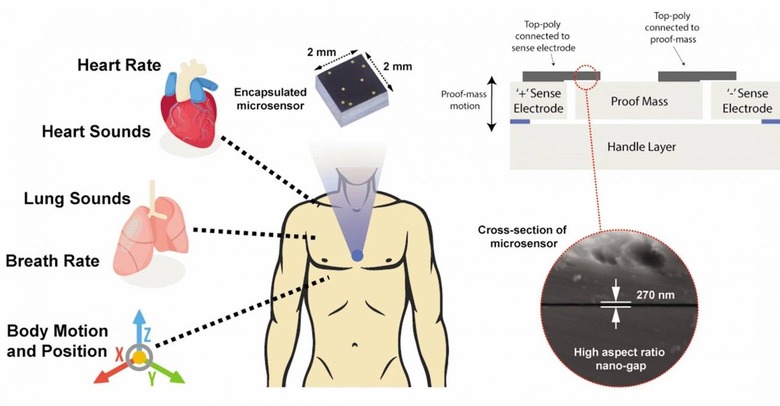This Tiny Sensor Records Lung And Heart Signals
Researchers at the Georgia Institute of Technology have created a new and very small sensor chip that's able to record multiple lung and heart signals along with body movements. The researchers believe that the new chip could enable a future with improved remote health monitoring. The chip itself is manufactured of two layers of silicon that overlay each other separated by the space of 270 nanometers.
Each of the chip layers carries a minute voltage. Vibrations from body motion and sounds create flux inside the chip, which makes the voltage fluctuate too. That fluctuation creates readable electronic outputs that, in human testing, allow the chip to record a variety of signals from the mechanical workings of the lungs and heart. The team says that the sensor can capture signals from the heart and lungs with clarity that is often lacking with current medical technology.

The tiny chip acts as an advanced electronic stethoscope and an accelerometer in one device. Its official name is the accelerometer contact microphone, and it's able to detect vibrations into the chip from inside the body while simultaneously keeping distracting noise from outside the body from the data it collects. The team says that means if the chip rubs on someone's clothing, it doesn't pick up those sounds while being able to pick up sounds from within the body.
Another benefit of the small chip is that the signals from the heart and lungs are recorded in sync, potentially offering caregivers a clear picture of the patient's lung and heart health overall. During the study, the researchers were able to record what's known as a "gallop," which is a faint third sound the heart makes after the "lub-dub" of the heartbeat. Those gallops are challenging to record and are said to be clues relating to heart failure.
Designing the chip took a decade's worth of work because of the tiny scale of the gap between the two silicon layers. The gap can have no contact, not even by forces in the air between layers. The team had to hermetically seal the sensor inside a vacuum chamber. That tiny space is what allows the sensor to record the ultra-low signal-to-noise and bandwidth that are unique to its design.
